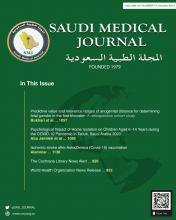Research ArticleOriginal Article
Open Access
Psychological impact of home isolation on children aged 6-14 years during the COVID-19 pandemic in Tabuk, Saudi Arabia 2020
Khalil Abu Jamileh, Ibrahim Al Hariri, Mohammad R. Ali, Nasrin S. Saiyed, Ibrahim M. Farouk, Khalid H. Makki, Nehal A. Al Salami, Seham S. Aly, Mustafa Al Toonisi and Menahi Al Subaie
Saudi Medical Journal October 2021, 42 (10) 1095-1102; DOI: https://doi.org/10.15537/smj.2021.42.10.20210091
Khalil Abu Jamileh
From the Family Medicine Department (Abu Jamileh, Al Hariri, Ali, Farouk, Makki, Al Salami, Aly), from the Research Department (Saiyed), from the Pediatric Department (Al Toonisi), and from the Psychiatric Department (Al Subaie), King Salman Armed Forces Hospital, Tabuk, Kingdom of Saudi Arabia.
RCGPIbrahim Al Hariri
From the Family Medicine Department (Abu Jamileh, Al Hariri, Ali, Farouk, Makki, Al Salami, Aly), from the Research Department (Saiyed), from the Pediatric Department (Al Toonisi), and from the Psychiatric Department (Al Subaie), King Salman Armed Forces Hospital, Tabuk, Kingdom of Saudi Arabia.
SBFMMohammad R. Ali
From the Family Medicine Department (Abu Jamileh, Al Hariri, Ali, Farouk, Makki, Al Salami, Aly), from the Research Department (Saiyed), from the Pediatric Department (Al Toonisi), and from the Psychiatric Department (Al Subaie), King Salman Armed Forces Hospital, Tabuk, Kingdom of Saudi Arabia.
MRCGPNasrin S. Saiyed
From the Family Medicine Department (Abu Jamileh, Al Hariri, Ali, Farouk, Makki, Al Salami, Aly), from the Research Department (Saiyed), from the Pediatric Department (Al Toonisi), and from the Psychiatric Department (Al Subaie), King Salman Armed Forces Hospital, Tabuk, Kingdom of Saudi Arabia.
MScIbrahim M. Farouk
From the Family Medicine Department (Abu Jamileh, Al Hariri, Ali, Farouk, Makki, Al Salami, Aly), from the Research Department (Saiyed), from the Pediatric Department (Al Toonisi), and from the Psychiatric Department (Al Subaie), King Salman Armed Forces Hospital, Tabuk, Kingdom of Saudi Arabia.
MRCGPKhalid H. Makki
From the Family Medicine Department (Abu Jamileh, Al Hariri, Ali, Farouk, Makki, Al Salami, Aly), from the Research Department (Saiyed), from the Pediatric Department (Al Toonisi), and from the Psychiatric Department (Al Subaie), King Salman Armed Forces Hospital, Tabuk, Kingdom of Saudi Arabia.
GPNehal A. Al Salami
From the Family Medicine Department (Abu Jamileh, Al Hariri, Ali, Farouk, Makki, Al Salami, Aly), from the Research Department (Saiyed), from the Pediatric Department (Al Toonisi), and from the Psychiatric Department (Al Subaie), King Salman Armed Forces Hospital, Tabuk, Kingdom of Saudi Arabia.
MRCGPSeham S. Aly
From the Family Medicine Department (Abu Jamileh, Al Hariri, Ali, Farouk, Makki, Al Salami, Aly), from the Research Department (Saiyed), from the Pediatric Department (Al Toonisi), and from the Psychiatric Department (Al Subaie), King Salman Armed Forces Hospital, Tabuk, Kingdom of Saudi Arabia.
MRCGPMustafa Al Toonisi
From the Family Medicine Department (Abu Jamileh, Al Hariri, Ali, Farouk, Makki, Al Salami, Aly), from the Research Department (Saiyed), from the Pediatric Department (Al Toonisi), and from the Psychiatric Department (Al Subaie), King Salman Armed Forces Hospital, Tabuk, Kingdom of Saudi Arabia.
MBBS, DCHMenahi Al Subaie
From the Family Medicine Department (Abu Jamileh, Al Hariri, Ali, Farouk, Makki, Al Salami, Aly), from the Research Department (Saiyed), from the Pediatric Department (Al Toonisi), and from the Psychiatric Department (Al Subaie), King Salman Armed Forces Hospital, Tabuk, Kingdom of Saudi Arabia.
SB-Psych
References
- 1.↵
- Khan I,
- Haleem A,
- Javaid M.
- 2.↵
- Armocida B,
- Formenti B,
- Ussai S,
- Palestra F,
- Missoni E.
- 3.↵
- Meo SA.
- 4.↵
- Donthu N,
- Gustafsson A.
- 5.↵
- 6.↵
- 7.↵
- 8.↵
- 9.
- 10.
- 11.↵
- 12.↵
- Asselmann E,
- Borghans L,
- Montizaan R,
- Seegers P.
- 13.
- 14.↵
- 15.↵
- 16.
- Liu JJ,
- Bao Y,
- Huang X,
- Shi J,
- Lu L.
- 17.↵
- Singh S,
- Roy MD,
- Sinha CP,
- Parveen CP,
- Sharma CP,
- Joshi CP.
- 18.↵
- 19.↵
- Langenkamp A,
- Cano T,
- Czymara CS.
- 20.↵
- Etheridge B,
- Spantig L.
- 21.↵
- Klaiber P,
- Wen JH,
- DeLongis A,
- Sin NL.
- 22.↵
- 23.↵
- 24.↵
- Meyer J,
- McDowell C,
- Lansing J,
- Brower C,
- Smith L,
- Tully M, et al.
- 25.↵
- 26.↵
- de Miranda DM,
- da Silva Athanasio B,
- de Sena Oliveira AC,
- Silva AC.
- 27.↵
- 28.↵
- Iqbal SA,
- Tayyab N.
- 29.↵
- Xue Q,
- Xie X,
- Liu Q,
- Zhou Y,
- Zhu K,
- Wu H, W, et al.
- 30.↵
- Idoiaga N,
- Berasategi N,
- Eiguren A,
- Picaza M.
- 31.↵
- Arora, R. and
- S.P. Singh
- 32.↵
- Caffo EF
- 33.↵
- Gassman-Pines, A.,
- E.O. Ananat, and
- J. Fitz-Henley
- 34.↵
- Ramkissoon H.
- 35.↵
- Górnicka M,
- Drywień ME,
- Zielinska MA,
- Hamułka J.
- 36.↵
- 37.↵
- Zhou X.
- 38.↵
In this issue
Psychological impact of home isolation on children aged 6-14 years during the COVID-19 pandemic in Tabuk, Saudi Arabia 2020
Khalil Abu Jamileh, Ibrahim Al Hariri, Mohammad R. Ali, Nasrin S. Saiyed, Ibrahim M. Farouk, Khalid H. Makki, Nehal A. Al Salami, Seham S. Aly, Mustafa Al Toonisi, Menahi Al Subaie
Saudi Medical Journal Oct 2021, 42 (10) 1095-1102; DOI: 10.15537/smj.2021.42.10.20210091
Psychological impact of home isolation on children aged 6-14 years during the COVID-19 pandemic in Tabuk, Saudi Arabia 2020
Khalil Abu Jamileh, Ibrahim Al Hariri, Mohammad R. Ali, Nasrin S. Saiyed, Ibrahim M. Farouk, Khalid H. Makki, Nehal A. Al Salami, Seham S. Aly, Mustafa Al Toonisi, Menahi Al Subaie
Saudi Medical Journal Oct 2021, 42 (10) 1095-1102; DOI: 10.15537/smj.2021.42.10.20210091
Jump to section
Related Articles
- No related articles found.
Cited By...
- No citing articles found.





